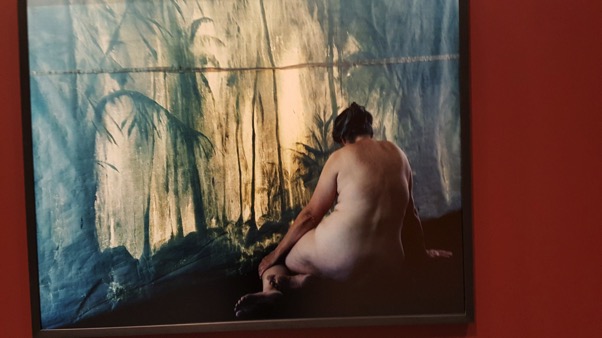Review: Michael Gill, "CAN Journal"
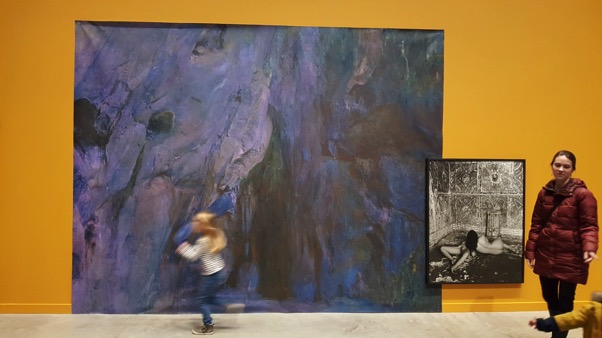
One of the things people say in describing the magnificence of opera is that it combines all art forms. We think of it as a musical experience, and we remember the composers, but it is also visual, theatrical, dramatic, poetic, sometimes even including dance, and no single component delivers the whole experience.
Esther Teichmann’s Heavy the Sea, on view now through April 30 at Transformer Station is primarily visual, and it doesn’t have a singer, but it does weave tragic tales in prose and poetry, and it does come with music composed as a part of the exhibit, performed live several times by the quartet Opus 216 throughout its run at Transformer Station. The exhibit in Cleveland is Teichman’s first solo show in the US.
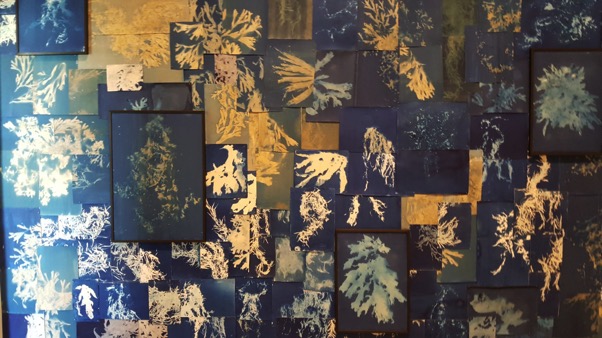
Cyanotype collage from Heavy the Sea, by Esther Teichmann
Like the composer of an opera, Teichmann is the prime mover of Heavy the Sea, having created the photography and mixed media works, as well as three short films, and having chosen collaborators to complete her vision. Indeed, to create the whole of the exhibit, she worked with writer Carol Mavor, composer Deirdre Gribbin, the musicians of Cleveland-based string quartet Opus 216, as well as a costumer who put the musicians in tunics. And the exhibit really works as the sum of its parts. You’ve got to take it all in.
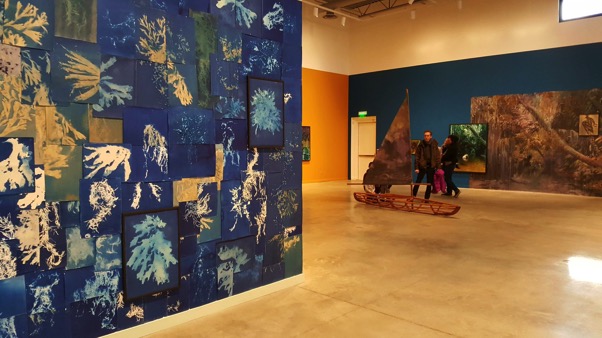
Entering the Western Gallery at Transformer Station, for Esther Teichmann’s Heavy the Sea
On the first Saturday in March, Opus 216 performed Gribbin’s “Fulmine” several times in the darkened, eastern gallery of Transformer Station. By itself, Fulmine—which refers to the stormy action of thunder and lightening, and which is also the name of a forthcoming mongraph by Teichmann—is a bit like a short tone poem for string quartet, its rhythmic notes behaving like color in a color field painting: that itself is what it seems to be about, and it would stand as such on its own. In the context of the room, though, Fulmine sets a mood for a classically tragic tale of beauty, loning, death, and loss, and maybe redemption through creation.
Surrounding the quartet’s performance space are three screens, where Teichmann’s films –maybe more accurately moving pictures–are projected: one follows the deliberate strokes of a bare chested man in a canoe, paddling a river with purpose, as if searching for something, or someone. Another offers a lush green forest, a jungle of trees and climbing vines overwhelming them. A third portrays a woman on a bed, lolling with slow abandon, as in a Butoh dance performance. She evokes a body given up to water, lifeless, moved not by her will, but by the currents that surround her. 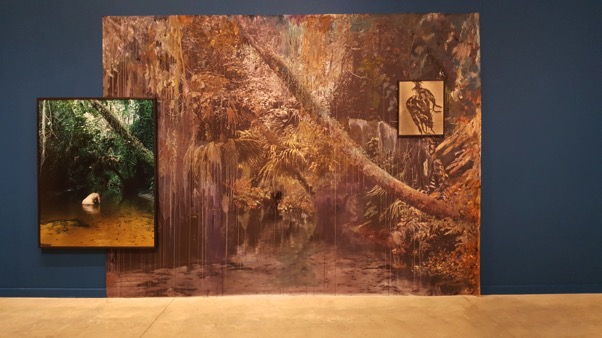
Juxtaposed images hint at stories in Esther Teichmann’s Heavy the Sea
In the western gallery are photo-based multimedia works, some dripping with ink or paint to add color and layers, in some cases to add the element of time by the juxtaposition of two images of the same scene with a detail changed. One juxtaposition presents a photographic image of the same forest pondscape twice. In one of these, a richly colored photograph, there’s a nude woman bathing. She’s gone from its much larger counterpart, which is the same setting made dreamlike by faded colors and by streaks of paint running down from the foliage. What happened to her? Where did she go? Is she now—as a third image of seaweed juxtaposed may imply—rolling beneath the surface of the water?
Elsewhere in the gallery, a large installation of perhaps 100 cyanotypes portrays a dreamy world of underwater plant life, all the more ethereal because of the medium’s soft-edged information, and shades of blue. In the center of the room, there’s the wooden skeleton of a small sailboat. On surrounding walls, two images, both photo-based and complicated by the addition of ink, feature a person and a boat. In one a man guides a canoe as he walks next to it in shallow water. Perhaps he is preparing to embark. Perhaps he is coming ashore. In the other, a woman paddles lazily while the man sleeps in an inflatable boat, in a swamp of shallow water and dead trees. By the way the people are outfitted, these are short journeys, maybe an afternoon’s reverie. But the overwhelming sense from the whole of the exhibit is that these are precursors to loss.
From Esther Teichmanns Heavy the Sea
Each of these individual works described stand on their own, with a presence and beauty that speaks for itself. The pictures gush beauty, in their rich color palates, and also in their contents, both the landscapes and the people. In one image, a nude woman with hair that hangs to the floor stands in a mysterious room that looks like poseiden’s cave, with pillars and a vaulted ceiling, and the walls densely crusted with seashells. But each of the images also gains from the context of the entire exhibit. Even without the music and story, the images of Heavy the Sea might be metaphorically described as operatic. They have a grand, luxurious, romantic drama, classical composition, and plenty of visual allusions to art history. The exhibit is accompanied by a slim volume of short stories by Esther Teichmann and poetry by Carol Mavor, with stitched together excerpts from Sapho, George Macdonald, Paul Celan, Dante, and others. The stories and poems offer several different readings of the exhibit, but all have in common a mood of darkness, deep emotion, longing, risk, and tragedy as characters flirt with death. Teichmann’s story Heavy the Sea–which gives the exhibit its name–ends after a moment’s decision between a lover and the sea, like this: The rolling waves turn violently, breaking rhythm, no longer a gentle embrace. She should leave now, return to the rapidly diminishing shore, come back to her body, her separateness, lie beside him as though she had never left. Reluctance lingers and she hesitates too long. Raised up, tossed and recaptured, dragged under by a raging weight, her body sags, resistance futile. Every part of her is penetrated, pummeled by the howling sea. She gives in to the fury, knowing that only then will it release her. The skies turn upside down and as suddenly as she had found herself drowning, she is now expelled, thrown towards land. She lies motionless, half submerged, eyes closed, returning slowly. Rain pours down, washing the salt away. And still it clings to her, seaweed in hair, Medusa writhing. The whole exhibit is like that. You’ve got til the end of April to check it out, and one more chance to take it all in with music by Opus 216. Heavy the Sea: Works by Esther Teichmann: January 14 – April 30, 2017 Performance by OPUS 216: 2 pm March 4 Artist Talk: 2 pm April 1 Performance by OPUS 216: 2 pm April 29



